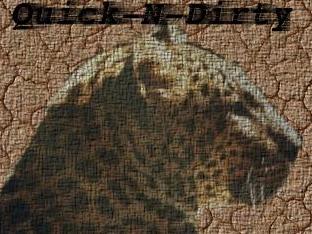
 This work is licensed under a
Creative Commons License
This work is licensed under a
Creative Commons License

 This work is licensed under a
Creative Commons License
This work is licensed under a
Creative Commons License
This guide demonstrates how to set up Mlterm, probably because you want a lightweight, UTF-8-capable terminal emulator that can do transparency. Or at least that is why I switched to Mlterm.
Here is what we are trying to achieve:
You must install Mlterm before you can use it! For help on this, see "The Quick-N-Dirty Guide to Finding and Installing Software" or your distribution's documentation.
Once you have Mlterm installed, you will need to write a very minimal config file before you are ready to actually use it. Here's how.
# Transparency settings (http://www.qnd-guides.net/qnd-mlterm.html#config_trans)
use_transbg = true
brightness = 20
fade_ratio = 75# Colour settings (http://www.qnd-guides.net/qnd-mlterm.html#config_colour)
fg_color = white
bg_color = black# Decoration settings (http://www.qnd-guides.net/qnd-mlterm.html#config_decor)
scrollbar_mode = none
borderless = true# Geometry settings (http://www.qnd-guides.net/qnd-mlterm.html#config_geom)
fontsize = 14
geometry = 90x35
use_anti_alias = falsegeometry settings to match.
So if you want sexy, anti-aliased fonts (as opposed the very unsexy ones that Mlterm wants to use by default), you will need to first install some. I recommend the GNOME project's lovely Bitstream Vera. For help on installing fonts, see "The Quick-N-Dirty Guide to Finding and Installing Software" or your distribution's documentation.
Once you have the fonts installed, you will need to open a new file in your text editor: ~/.mlterm/aafont. To this file, add the following (assuming you are using the aforementioned Bitstream Vera font):
ISO8859_1 = bitstream vera sans mono-medium-iso8859-1;
ISO8859_15 = bitstream vera sans mono-medium-iso8859-15;
ISO10646_UCS2_1 = bitstream vera sans mono-medium-iso10646-1;
ISO10646_UCS2_1_BOLD = bitstream vera sans mono-bold-iso10646-1;
After you create the ~/.mlterm/aafont file, you will need to update your ~/.mlterm/main file to use anti-aliased fonts. Find the # Geometry settings line (that you created in the previous section) and change it to read:
# Geometry settings (aafont) (http://www.qnd-guides.net/qnd-mlterm.html#config_aafont)
fontsize = 12
geometry = 90x35
use_anti_alias = true# Bell settings (http://www.qnd-guides.net/qnd-mlterm.html#config_bell)
bel_mode = visual# Scrollback settings (http://www.qnd-guides.net/qnd-mlterm.html#config_buf)
logsize = 4096# Terminal settings (http://www.qnd-guides.net/qnd-mlterm.html#config_name)
name = xterm# Selection settings (http://www.qnd-guides.net/qnd-mlterm.html#config_sel)
word_separators = " ,;="One really handy feature of Mlterm is the ability to switch character encodings on the fly (just like you can in a web browser). The easiest way to do this is to hold down the Ctrl key and right-click anywhere in the terminal window. This will bring up the "mlterm configuration" dialog. Click in the "Encoding" dropbox (the default setting should be "auto (currently UTF-8)") and select the encoding that you need (e.g. "EUC-JP", "SJIS", "CP1251 (Bulgarian,Belarusian)", etc.).
Of course, one of the main reasons that you want a multi-lingual terminal emulator is probably so you can input Japanese, or Korean, or Chinese, or Cyrillic, or something like that. Thus far, I have only figured out how to input Japanese with uim-anthy. Add the following to your ~/.mlterm/main file:
# Input settings (http://www.qnd-guides.net/qnd-mlterm.html#m17n_input)
input_method = uimLC_CTYPE='ja_JP.utf8' mltermI will attempt to figure out how to use other input methods with Mlterm for future revisions of this document. If you find working configurations, please email me at jmglov***replace_with_at-sign***jmglov.net.
The geometry configuration sub-section deals only with FluxBox at 1280x1024. Here are some geometry line for other window manager / resolution permutations:
fontsize = 12
geometry = 72x24use_anti_alias = false# Terminal settings (http://www.qnd-guides.net/qnd-mlterm.html#config_name)